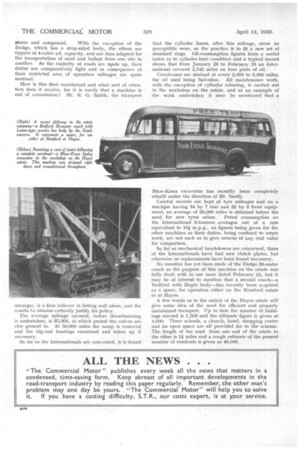ROAD MOTORS HELP TO BI JD VAST HCUSING ESTATES
Page 42

Page 43

Page 44

If you've noticed an error in this article please click here to report it so we can fix it.
Little Respite Without Beir Excellent Re( and Service. Policy Makc
:hines Which, )n-fed, Show )1 Reliability Well Alone" Efficiency in !et
AMONGST the largest building estates to be developed within easy reach of the Metropolis, during the past 10 or 15 years, are those for which Mr. T. F. Nash is responsible. Wide country areas in Harrow, Romford, Hayes, St. Albans and Sevenoaks have been or are being transformed into miniature towns. The objects achieved are the result of what one might say is intensive jnechanization in those sections where manual labour is not strictly required.
Taking the site at Hayes, Middlesex, as an example, six Internationals, three Studebakers, a Bedford and a Dodge are responsible for all haulage work. The International machines are all engaged on sand and ballast cartage, whilst the remaining vehicles are used for general haulage within the confines of the estate.
Then there is a particularly serviceable outfit in a Fordson tractor with a Chaseside high-lift loader attachment. This is used in conjunction with the cement mixers. A Blaw Knox Insley excavator, with a Buda 33 h.p. petrol engine, makes easy work of trench digging; Barford 50-cwt. rollers are kept busy all over the estate and a number of rail tractors, with si h.p. petrol engines, plug away, hour after hour, hauling their loads of concrete from the Illbiers to various blocks of foundations.
Regarding the commercial vehicles, one of the Internationals is a rigid six-wheeler with an 11-cubic-yd. tipping body, and the others, all tippers, have 4-cubicyd. bodies. The rigid six-wheeler is undoubtedly a fine machine and as an example of its capacity for getting the job done it may be mentioned that, between March 27 and April 1, 39 loads accounted for 351 cubic yds. ot material.
Other figures which may be of interest, and which show that the lorries earn their keep, may be quoted.
From July, 1937, to June, 1938, the combined efforts of the Internationals accounted for 11,567 loads of material, and from July 1, 1938 to March of this year, another 8,413 loads went to their credit.
A full day's work means a mileage of 170 for the atonners, which is equivalent to 11 loads per day, whilst the six-wheeler averages eight loads per day.
Reference has been made to the work of the other machines which go to make up the fleet as being confined to duties on the estate, and quite a considerable proportion of this work is timber haulage from the stores and compound. With the exception of the Dodge, which has a drop-sided body, the others are tippers of 4-cubic-yd. capacity, and are thus adapted for the transportation of sand and ballast from one site to another. As the majority of roads are gade up, their duties are comparatively light and in consequence of their restricted area of operation mileages are quite nominal.
• How is this fleet maintained and what sort of attention does it receive, for it is rarely that a machine is out of commis:Sion? Mr. R. G. Smith, the transport
manager, is a firm believer in letting well alone, and the results he obtains certainly justify his policy.
The average mileage covered, before decarbonizing is undertaken, is 35,000, at which period the valves are also ground in. At 50,000 miles the sump is removed and the big-end bearings examined and taken up if necessary.
So far as the Internationals are concerned, it is found that the cylinder liners, after this mileage, show no perceptible wear, so the practice is to fit a new set of standard rings. Oil-consumption figures form a useful index as to cylinder-bore condition and a typical record shows that from January 28 tO February 18 an International covered 2,542 miles on four pints of oil.
Crankcases are drained at every 2,000 to 3,000 miles, the oil used being Salvoline. All maintenance work, with the exception of cylinder reboring, is carried out in the workshop on the estate, and as an example of the work undertaken it may be mentioned that a
Blaw-Knox excavator hnq recently been completely rebuilt under the direction of Mr. Smith.
Careful records are kept 0 tyre mileages and on a machine having 34 by 7 rear and 32 by 6 front equipment, an average of 28,000 miles is obtained before the need for new tyres arises. Petrol consumption on the International 3-tonners averages out at a rate equivalent to NI m.p.g., no figures being given for the other machines as their duties, being confined to estate work, are not such as to give returns of any real value for comparison.
So far as mechanical breakdowns are concerned, three of the Internationals have had new clutch plates, but otherwise no replacements have been found necessary.
No mention has yet been made of the Dodge 32-seater coach as the purpose of this machine on the estate was fully dealt with in our issue dated February 24, but it may be of interest to mention that a second coach—a Bedford with Duple body—has recently been acquired as a spare, for operation either on the Romford estate or at Hayes.
A few words as to the extent of the Hayes estate will give some idea of the need for efficient and properly maintained transport. Up to date the number of buildings erected is 1,500 and the ultimate figure is given at 4,000. Three schools, a church, hotel, shopping centre and an open space are all provided for in die scheme. The length of the road from one end of the estate to the other is 11 miles and a rough estimate of the present number of residents is given as 40,000.




















































































